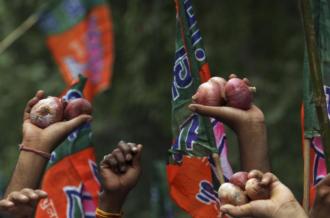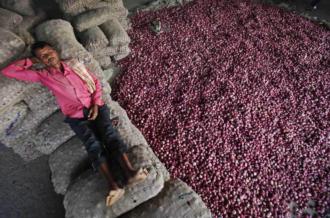Why onions bring tears to Indian eyes
Onions become political hot potatoes as prices soar and ruling governments feel the heat.

Mubai, India – For weeks Neelima Sarkar has tried hard to keep onions off the lunch and dinner menu, but the 36-year-old Mumbai-based housewife admits it has not been easy managing her family’s taste palate and the monthly budget simultaneously.
“Onions are simply too expensive these days, but cooking without onions is not easy either,” Sarkar said. “But I have been cooking dishes that don’t need too many onions, or none at all.”
Like Sarkar, most Indians face an equally difficult time as retail prices of onions have risen four times to as high as 100 rupees ($1.62) per kilogramme in the last three months, making this essential vegetable disappear from the kitchens of many Indian households.
In a country used to food inflation, the current spike in prices would have been dismissed as routine – had it not been onions.
In India, onions are more than a simple vegetable mixed into fare to add flavour. Over the decades, onions have acquired a degree of political significance, even wielding enough power to bring down governments.
Indians consume 16.5 millions tonnes of onions a year and use them as a key ingredient in traditional dishes and also serve raw onions as part of salad recipes. The country is the second-largest onion grower in the world after China, and usually a net exporter.
“No wonder, onions with their skyrocketing prices, have become political hot potatoes,” said journalist Debabrata Mohanty.
Ticking time-bombs
Elections are looming – five states will in a month’s time go to polls viewed by many as semifinals to next year’s general elections – and authorities are already feeling the heat.
Seen by many pundits as political ticking time-bombs, in the capital, New Delhi, prominent opposition leader Vijay Jolly presented Chief Minister Sheila Dikshit with a basket of onions last week as a gift. It was unlikely the underlying message was lost on the chief minister, who is seeking re-election in December polls.
According to government data, onion production in India was 16.65 million tonnes in the last fiscal year, 4.8 percent lower than the year before. Alarmed by the situation, government authorities have rushed in to manage the crisis, a large part of which officials say is man-made.
Ever since onion prices began spiking in August, India’s Food Minister KV Thomas has repeatedly blamed hoarders for the high prices and ordered a crackdown against them. The minister alleged hoarders were keeping large onion consignments from reaching the markets to artificially inflate prices and book increased profits.
Concurrently, India’s federal government has also decided to import onion stocks from countries such as Egypt and Pakistan to meet any additional demand during the ongoing festive season in the country. But despite such measures, little has changed on the ground, and onions still continue to be beyond the price reach of a majority of consumers.
Political fallout
Unable to tame prices, those in power have reasons to worry. In a similar rerun of events in 1998, the Bhartiya Janata Party (BJP), one of India’s largest political parties, lost power in provincial elections in New Delhi after onion prices went on a similar upward spiral.
Since then the BJP has never managed to come back to power in Delhi.
Incidentally, former Indian Prime Minister Indira Gandhi, staged a remarkable political comeback, riding a groundswell of public anger over onion prices in 1980.
With Delhi state elections due in December, the ruling Congress party government led by Chief Minister Dikshit is in no mood to anger voters. Last week, the her government opened special onion outlets to supply cheaper onions to consumers across the state.
Dikshit’s ministers have also dropped hints that the hike in onion prices was the handiwork of hoarders backing her political opponents.
 |
|
Bharatiya Janata Party activists hold onions during a protest in New Delhi [AP] |
Though the move to sell cheap onions may go well with Delhi voters, the situation remains grim in the rest of the country. Analysts say the main issue is lack of an efficient supply-chain system in India, which leads to huge wastage despite good crops in most years.
According to government data, India wastes 40 percent of its agriculture produce to the tune of Rs 50,000 crore ($13bn) every year due to lack of cold storage facilities and energy infrastructure, while only eight percent of the produce is processed.
“The biggest reason that the onion prices have spiked is the inefficiency in supply-chain management. It is not that the stock is not available, it is just that the management and storage hasn’t been done well,” said Kaustav Choksi, a Kolkata-based commodities trader.
“It is not just onion, it is happening with other vegetables, too. It is just that onion prices have come in the limelight, as the quantum of increase is higher in case of onions,” he told Al Jazeera.
Difficult situation
But with a high fiscal deficit and slowing economic growth, the Indian government may find it extremely difficult to invest more in the back-end supply chain that the country’s food and agriculture sector badly needs.
“It’s a difficult situation before the government,” said Ashok Bhargav, a Mumbai-based finance professional.
“If they don’t invest they risk a similar situation again, but if they invest then risk a higher fiscal deficit which may have negative fallouts for the economy, at least in the short term,” he told Al Jazeera.
The government has, however, been trying to attract private investment in the country’s food supply chain infrastructure.
Last year, the Indian government made it mandatory for foreign companies to put at least 50 percent of their total investment into back-end infrastructure. But so far that has yet to bear fruit.
 |
| Many blame the crisis on poor storage facilities [Reuters] |
For a country with a billion-plus population, the rising onion price is just one example of how bad the food distribution situation is, especially for India’s poor who often live on less than a dollar per day.
Food inflation in India has remained in double digits for more than five years now, and despite several policy moves, it shows no sign of abating.
“Rising onion prices will fuel food inflation further,” said Ramnath Pradeep, former chairman and managing director of Corporation Bank, a leading government owned bank in India.
“And this will again put further pressure on the Reserve Bank of India to tighten interest rates,” he told Al Jazeera.
“It’s a catch-22 situation before the country but I feel a lot of difference can be made by controlling supply side bottlenecks in the economy,” he said. “Whether it is creating supply chain infrastructure or tackling the onion hoarders, the government has to act fast and in a far more decisive manner.”
With less than a year to go before India elects its next government, the onion price situation will leave voters with some food for thought on who they will choose.